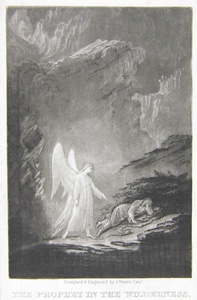| Method | Mezzotint with etching |
| Artist | John Martin |
| Published | 1826 |
| Dimensions | Image 105 x 71 mm, Sheet 117 x 73 mm |
| Notes |
Proof impression on India laid paper, with full lettering. Illustration to James Montgomery's Elijah in the Wilderness. The poem was based on Kings 1:19, and published in The Amulet; or, Christian and Literary Remembrancer. The Amulet was one of several annuals which served as a lucrative outlet for engravers. Introduced in the 1820's, these annuals were an outgrowth of earlier pocket-books or almanacs, and were usually published during festive periods in order to attract buyers. Amongst Martin's literary friends were Alaric Watts of the Literary Souvenir and Samuel Carter Hall of The Amulet, so it was somewhat inevitable that Martin should participate in this fashionable and profitable form of publication. In addition to this print, Martin provided over twenty designs for annuals between the years of 1826 and 1837. Elijah, having fleed from the wrath of Jezebel, takes shelter and rest under a juniper tree. It is here that the angel visits him and Martin's print shows this very act. The spirit, who illuminates the wilderness, brings Elijah bread and water in order to sustain his trip to Mount Horeb. John Martin (1789-1854) was an English painter, illustrator and mezzotint engraver. He achieved huge popular acclaim with his historical landscape paintings which featured melodramatic scenes of apocalyptic events taken from the Bible and other mythological sources. Influenced by the work of J.M.W. Turner (1775-1851) as well as Theodore Gericault (1791–1824), Eugene Delacroix (1798–1863) and Paul Delaroche (1797–1856), his paintings are characterised by dramatic lighting and vast architectural settings. Most of his pictures were reproduced in the form of engravings, and book engravings, from which he derived his fortune. Despite his popularity, Martin's work was spurned by the critics, notably John Ruskin, and he was not elected to the Royal Academy. His fame declined rapidly after his death, although three of his best known works of religious art toured Britain and America in the 1870s: The Great Day of his Wrath (1853, Tate, London), The Last Judgment (1853, Tate) and The Plains of Heaven (1851-3, Tate). A great contributor to English landscape painting, Martin was a key influence on Thomas Cole (1801-48), one of the founding members of the Hudson River School. CW 76; Campbell, Visionary Printmaker, p. 93. Condition: Trimmed within plate mark. |
| Framing | unmounted |
| Price | £150.00 |
| Stock ID | 40789 |

